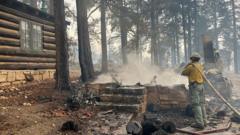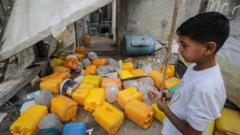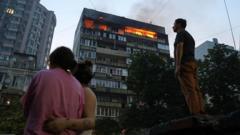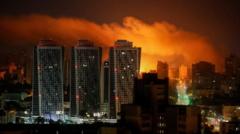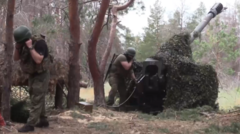As tensions surge in Eastern Ukraine, the reliance on drones has made both military logistics and civilian safety increasingly precarious.
**Drones Amplify Perils for Civilians and Soldiers in Eastern Ukraine**

**Drones Amplify Perils for Civilians and Soldiers in Eastern Ukraine**
Escalating drone warfare complicates humanitarian efforts and military operations as cease-fire talks struggle.
In Eastern Ukraine, the non-stop threat of drone strikes is redefining safety for both soldiers and civilians amidst ongoing conflict. As Russian forces ramp up their summer offensive, their strategic reliance on drones has intensified, garnering more control over contested territories. Within the towns of Kostiantynivka, Pokrovsk, and Kupiansk, Ukrainian troops face a daunting challenge: maintaining supply lines while avoiding increasingly aggressive aerial attacks.
Soldiers report that movement in any direction has become fraught with danger due to Russian drones equipped with thermal imaging technology, which can engage targets from as far as 24 miles away. Senior Lieutenant Yevhen Alkhimov of the 28th Separate Mechanized Brigade emphasizes that while establishing defensive positions allows for some operational capacity, the routes to and from these sites are perilous. Nighttime incursions offer little respite, with intensified drone activities persisting under the cover of darkness.
Civilians remaining in these conflict-ridden areas encounter ever-present risks. As humanitarian groups attempt to evacuate those unwilling or unable to leave, the same drone threats complicate their missions. Supplies must be transported expeditiously to mitigate risks, raising alarms for both military forces and non-combatants. Ajd the climate of increasing drone warfare creates an environment where every moving figure is a potential target, further entrenching the struggle for survival in Eastern Ukraine.
Soldiers report that movement in any direction has become fraught with danger due to Russian drones equipped with thermal imaging technology, which can engage targets from as far as 24 miles away. Senior Lieutenant Yevhen Alkhimov of the 28th Separate Mechanized Brigade emphasizes that while establishing defensive positions allows for some operational capacity, the routes to and from these sites are perilous. Nighttime incursions offer little respite, with intensified drone activities persisting under the cover of darkness.
Civilians remaining in these conflict-ridden areas encounter ever-present risks. As humanitarian groups attempt to evacuate those unwilling or unable to leave, the same drone threats complicate their missions. Supplies must be transported expeditiously to mitigate risks, raising alarms for both military forces and non-combatants. Ajd the climate of increasing drone warfare creates an environment where every moving figure is a potential target, further entrenching the struggle for survival in Eastern Ukraine.





